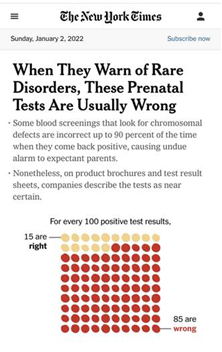Shop Talk
Positives - True or False
 We're not supposed to be writing. We’re on January break. But a funny thing happened this morning. While resting on the couch and doom scrolling over omicron, wildfires, and Betty White, we noticed that the Jan. 2nd, headline (headline!) of the New York Times (NYT) is about evidence-based practice. As if that’s not amazing enough, the article is perfectly on topic. It deals with diagnostic tests. Here’s a screenshot of the top story that caught our eye and drew our fingers to the keyboard:
We're not supposed to be writing. We’re on January break. But a funny thing happened this morning. While resting on the couch and doom scrolling over omicron, wildfires, and Betty White, we noticed that the Jan. 2nd, headline (headline!) of the New York Times (NYT) is about evidence-based practice. As if that’s not amazing enough, the article is perfectly on topic. It deals with diagnostic tests. Here’s a screenshot of the top story that caught our eye and drew our fingers to the keyboard:

The infographic and accompanying text describe the positive predictive value (PPV) of a particular type of prenatal screening. While the text and figure provide different values (85% vs. up to 90%), the point is clear. A positive test result is rarely correct. Let’s use the NYT example to define and compute PPV and better appreciate why the article is concerned about these tests.
What is PPV?
PPV is the proportion of individuals with a positive test result who truly HAVE a condition of interest. A perfect value for PPV is 1 (or 100%, if we use percentage format). When a diagnostic test has perfect PPV, we know that every positive test is a true case of the disease or condition.
How is PPV computed?
PPV is computed from 2x2 tables like the one below. Pay attention to A, B, and A + B. We’ll deal with C and D another day.

A + B = the total number of people with a positive test result
A = the number of people with a positive result who also HAVE the condition,
B = the number of people with a positive result who do NOT have the condition
Before you look at the equation, see if you can figure it out yourself. We want a value that represents the proportion of individuals with a positive test who really HAVE the condition.
Here’s the equation:
PPV = A / (A + B)
Now, let’s insert the values from the NYT infographic. It tells us that if 100 people get a positive test result, 15 will HAVE the condition and 85 will NOT have the condition.
The table looks like this:

A + B + C + D
A + B = 100 (total number of people with a positive test)
A = 15 (number of people with a positive test who HAVE the condition)
B = 85 (the number of people with a positive test who do NOT have the condition)
PPV = 15 / (15 + 85) = 0.15 (or 15%).
As the headline suggests, a positive test result is not very helpful. According to the values provided, only 15% of positive tests represent true cases. The other 85% are false positives. While subsequent (and more accurate) testing could eventually rule out concerning conditions and allay parents’ fears, tests with poor PPV risk unwarranted worry.
Thanks for reading. Unless the news compels us to write sooner, we’ll be back in February. If you see something in the headlines related to our mission, drop us a note in the contact section.
January Edition
Jan. 02, 2022
If you appreciate what we’re doing, please consider supporting our work -